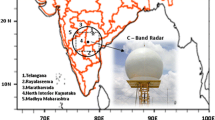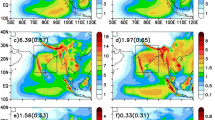Abstract
Rainfall mechanism over the rain-shadow region of north peninsular India during the summer monsoon season has been investigated using dynamic, thermodynamic, cloud microphysics and cloud dynamic (CMCD) forcings. Daily rainfall data has been used to understand rainfall variability. Daily ECMWF wind data for the period 2009–2011 have been used to study the wind divergence, shear and vertical velocity profiles. Daily thermodynamic parameters from upper air soundings of Hyderabad (17.448°N, 78.381°E), have been examined. Aircraft data have been used to study CMCD parameters. The divergence is found between surfaces to 850 hPa level whereas the convergence is at 850 hPa, which comes down to surface level during presence of low pressure systems. The divergence is observed at low (700 hPa), mid (600–300 hPa) and upper (250–150 hPa) tropospheric levels. In consequence of these divergence structures, three types of cloud systems viz. shallow, congestus and deep are developed with bases just above 850 hPa and tops at corresponding three divergent levels. The vertical profiles of relative humidity observed by radiosonde data have been analyzed to get the frequency distribution of shallow, congestus and deep clouds. The highest frequency observed is that of congestus clouds. The thermodynamic structure shows dry surface level and warm and moist middle troposphere with tongues of dry air and multilevel inversions which have been attributed to advection of aerosol-rich dry air. The aircraft observations showed high aerosol concentrations from surface to 5 km, polluted clouds with cloud droplet effective radius smaller than that required for collision–coalescence process. The factors which are responsible for causing low rainfall over the rain-shadow area have been identified.












Similar content being viewed by others
References
Ananthakrishnan R (1977) Some aspects of the monsoon circulation and monsoon rainfall. Pure Appl Geophys 115:1209–1244
Ananthakrishnan R, Rangarajan S (1963) Inversions and stable layers in the free atmosphere over India. J Meteorol Geophys 14:173–189
AWS (1979) The use of the skew of T, log P diagram in analysis and forecasting. Air weather service technical report, AWS/TR-79/006, Scott, AFB, IL
Betts AK, Ridgway W (1989) Climate equilibrium of the atmospheric convective boundary layer over a tropical ocean. J Atmos Sci 46:2621–2641
Bhat GS, Srinivasan J, Gadgil S (1996) Tropical deep convection, convective available potential energy and sea surface temperature. J Meteorol Soc Jpn 74:155–166
Braham RR Jr (1958) Cumulus cloud precipitation as revealed by radar_Arizona 1955. J Meteorol 15:75–83
Carlson TN, Benjamin SG, Forbes GS, Li YF (1983) Elevated mixed layers in the regional severe storm environment: conceptual model and case studies. Mon Weather Rev 111:1453–1473
Cooper WA, Bruintjes RT, Mather GK (1997) Some calculations pertaining to hygroscopic seeding with flares. J Appl Meteorol 36:1449–1469
Czys RR, Bruintjes RT (1995) A review of hygroscopic seeding experiments to enhance rainfall. J Weather Modif 26:41–52
Essenwanger O, Haggard GH (1962) Frequency of clouds in height layers for Berlin (Tempelhof). J Appl Meteorol 1:560–569
Gregory S (1987) A further note on extreme monsoonal rainfall deficits in India. Theor Appl Climatol 38:174–179
Gunnell Y (1997) Relief and climate in south Asia: the influence of the western Ghats on the current climate pattern of peninsular India. Int J Climatol 17:1169–1182
Harikishan G, Padmakumari B, Maheskumar RS, Pandithurai G, Min QL (2014) Macro physical and microphysical properties of monsoon clouds over a rain shadow region in India from ground-based radiometric measurements. J Geophys Res. doi:10.1002/2013JD020872
Holton JR, Hakim GJ (2012) An introduction to dynamic meteorology, 5th edn. Elsevier: Academic press, pp 1–532. doi:10.1016/B978-0-12-384866-6.00001-05
Houze RA Jr, Wilton DC, Smull BF (2007) Monsoon convection in the Himalayan region as seen by the TRMM precipitation radar. Q J R Meteorol Soc 133:1389–1411
Johnson RH, Ciesielski PE, Hart KA (1996) Tropical inversions near the 0 °C level. J Atmos Sci 53:1838–1855
Johnson RH, Rickenbach TM, Rutledge SA, Ciesielski PE, Schubert WH (1999) Trimodal characteristics of topical convection. J Clim 12:2397–2417
Koteshwaram P (1958a) The easterly jet stream in the tropics. Tellus 10:43–57
Koteshwaram P (1958b) The Asian summer monsoon and the general circulation over the tropics. Monsoons World 105–110
Kothawale DR, Munot AA, Krishna KK (2010) Surface air temperature variability over India during 1901–2007, and its association with ENSO. Clim Res 42:89–104. doi:10.3354/cr00857
Krishnamurti TN, Bhalme H (1976) Oscillations of a monsoon system. J Atmos Sci 33:1937–1954
Kulkarni JR, Maheskumar RS, Morwal SB, Padmakumari B, Konwar M, Deshpande CG, Joshi RR, Bhalwankar RV, Pandithurai G, Safai PD, Narkhedkar SG, Dani KK, Nath A, Nair S, Sapre VV, Puranik PV, Kandalgaonkar SS, Mujumdar VR, Khaladkar RM, Vijaykumar R, Prabha TV, Goswami BN (2012) Cloud Aerosol Interaction and Precipitation Enhancement Experiment (CAIPEEX): overview and preliminary results. Curr Sci 102:413–425
Maheskumar RS, Narkhedkar SG, Morwal SB, Padmakumari B, Kothawale DR, Joshi RR, Deshpande CG, Bhalwankar RV, Kulkarni JR (2013) Mechanism of high rainfall over the west coast and adjoining Arabian Sea area during the monsoon season. Clim Dyn. doi:10.1007/s00382-013-1972-9,1-17
Mapes B, Houze RA Jr (1992) An integrated view of the 1987 Australian monsoon and its mesoscale convective systems. I: horizontal structure. Q J R Meteorol Soc 118:927–963
Medina S, Houze RA Jr, Kumarb A, Niyogi D (2010) Summer monsoon convection in the Himalayan region: terrain and land cover effects. Q J R Meteorol Soc 136:593–616
Mitra AK, Bohra AK, Rajeevan MN, Krishnamurti TN (2009) Daily Indian precipitation analysis formed from a merge of rain-gauge data with the TRMM TMPA satellite-derived rainfall estimates. J Meteorol Soc Jpn 87A:265–279
Mooley DA, Shukla J (1987) Characteristics of the westward-moving summer monsoon low pressure systems over the Indian region and their relationship with the monsoon rainfall. Center for Ocean–Land–Atmosphere Interactions Report, University of Maryland. Available from COLA, IGES, 4041 Powder Mill Road, Suite302, Calverton, MD 20705, USA
Morwal SB, Maheskumar RS, Padmakumari B, Kulkarni JR, Goswami BN (2012) Cloud microphysical properties over Indian monsoon regions during CAIPEEX-2009. J Atmos Sol Terr Phys 81–82:76–85
Murakami M (1977) Spectrum analysis relevant to Indian monsoon. Pageoph 115:1145–1166
Neelin JD, Held IM (1987) Modelling tropical convergence based on moist static energy budget. Mon Weather Rev 115:3–12
Niyogi D, Chang H-I, Chen F, Gu L, Kumar A, Menon S, Pielke RA Sr (2007) Potential impacts of aerosol–land–atmosphere interactions on the Indian monsoonal rainfall characteristics. Nat Hazards 42:345–359. doi:10.1007/s11069-006-9085-y
Padmakumari B, Maheskumar RS, Harikishan G, Morwal SB, Prabha TV, Kulkarni JR (2013a) In situ measurements of aerosol vertical and spatial distributions over continental India during the major drought year 2009. Atmos Environ 80:107–121. doi:10.10.1016/j.atmosenv.2013.07.064
Padmakumari B, Maheskumar RS, Morwal SB, Harikishan G, Konwar M, Kulkarni JR, Goswami BN (2013b) Aircraft observations of elevated pollution layers near the foot hills of the Himalayas during CAIPEEX-2009. Q J R Meteorol Soc 139:625–638. doi:10.1002/qj.1989
Parthasarathy B, Sontakke NA, Munot AA, Kothawale DR (1987) Droughts/floods in summer monsoons season over different meteorological sub-divisions of India for the period 1871–1980. J Clim 1:57–70
Philip NM, Srinivasan V, Ramamurthy K (1973) Southwest monsoon-typical situations over interior Peninsula and coastal Andhra Pradesh. FMU Report III 3.9 The deputy Director General of Observatories, IMD
Poore K, Wang J, Rossow WB (1995) Cloud layer thicknesses from a combination of surface and upper-air observations. J Clim 8:550–568
Ramanathan KR, Ramakrishnan KP (1932) The Indian southwest monsoon and the structure of depressions associated with it. Memb India Meteorol Dep 26:13–36
Rao YP (1976) Southwest monsoon: meteorological monograph, synoptic met no 1/1976. India meteorological Department
Romatschke U, Houze RA Jr (2011) Characteristics of precipitating convective systems in the South Asian monsoon. J Hydrometeorol 12:3–26
Romatschke U, Medina S, Houze RA Jr (2010) Regional, seasonal, and diurnal variations of extreme convection in the south Asian region. J Clim 23:419–439
Sawyer JS (1947) The structure of the intertropical front over NW India during SW monsoon. Q J R Meteorol Soc 73:346–369
Srinivasan V, Sadasivan V (1975) Thermodynamic structure of the atmosphere over India during southwest monsoon season. Indian J Meteorol Hydrol Geophys 26:169–180
Starr DO, Cox SK (1980) Characteristics of middle and upper tropospheric clouds as deduced from rawinsonde data. Atmospheric science paper no 327. Department of Atmospheric Science, Colorado State University, Fort Collins, CO
Wang J, Rossow WB (1995) Determination of cloud vertical structure from upper-air observations. J Appl Meteorol 34:2243–2258
Williams E, Renno N (1993) An analysis of the conditional instability of the tropical atmosphere. Mon Weather Rev 121:21–36
Xie SP, Xu H, Saji NH, Wang Y, Liu WT (2006) Role of narrow mountains in large scale organization of Asian monsoon convection. J Clim 19:3420–3429
Acknowledgments
The authors wish to thank Director, IITM and Ministry of Earth Sciences (MoES), Govt. of India. The authors gratefully acknowledge the NOAA Air Resources Laboratory (ARL) for the provision of the HYSPLIT transport and dispersion model and/or READY website (http://ready.arl.noaa.gov), Wyoming University for the upper air data, ECMWF for providing the ERA Interim, Atmospheric model data used in this publication. Authors sincerely acknowledge the efforts of all the CAIPEEX team members for the successful completion of the CAIPEEX aircraft observations. The thanks are due to the staff and management group of Jay Prakash Narayan College of Engineering (JPNCE), Mahabubnagar for providing all the required facilities in conducting this campaign. Authors are also thankful to the anonymous reviewers for their critical comments which have improved the quality of the paper.
Author information
Authors and Affiliations
Corresponding author
Rights and permissions
About this article
Cite this article
Narkhedkar, S.G., Morwal, S.B., Padmakumari, B. et al. Rainfall mechanism over the rain-shadow region of north peninsular India. Clim Dyn 45, 1493–1512 (2015). https://doi.org/10.1007/s00382-014-2403-2
Received:
Accepted:
Published:
Issue Date:
DOI: https://doi.org/10.1007/s00382-014-2403-2




